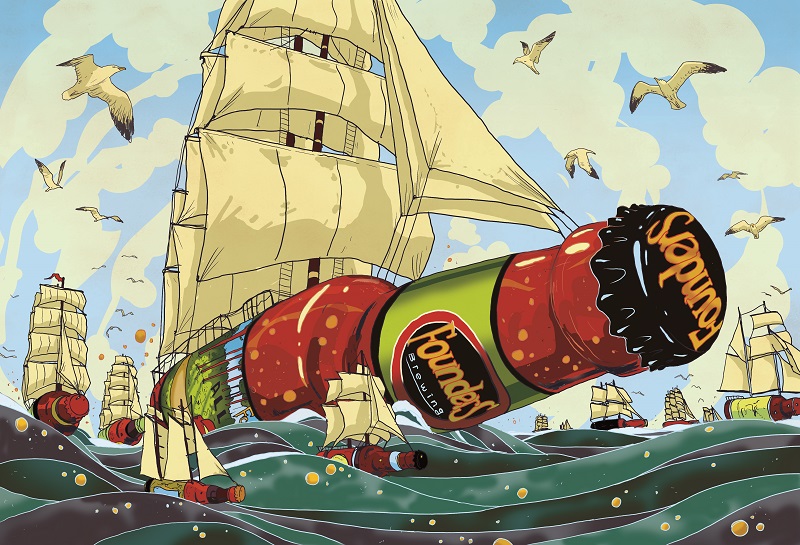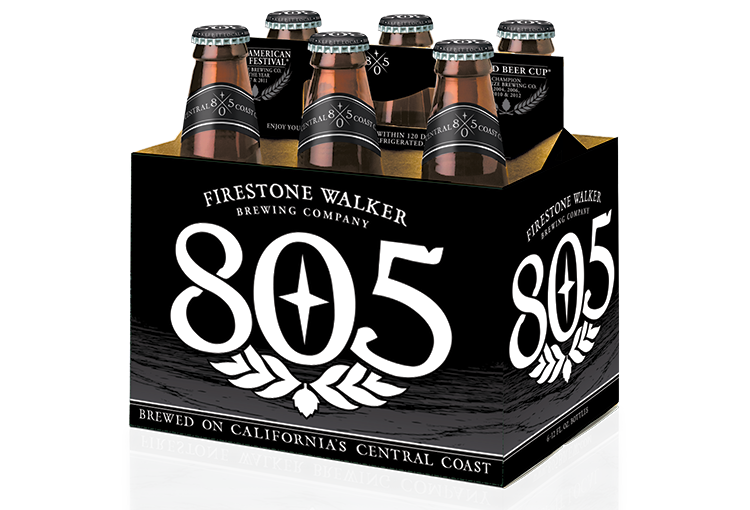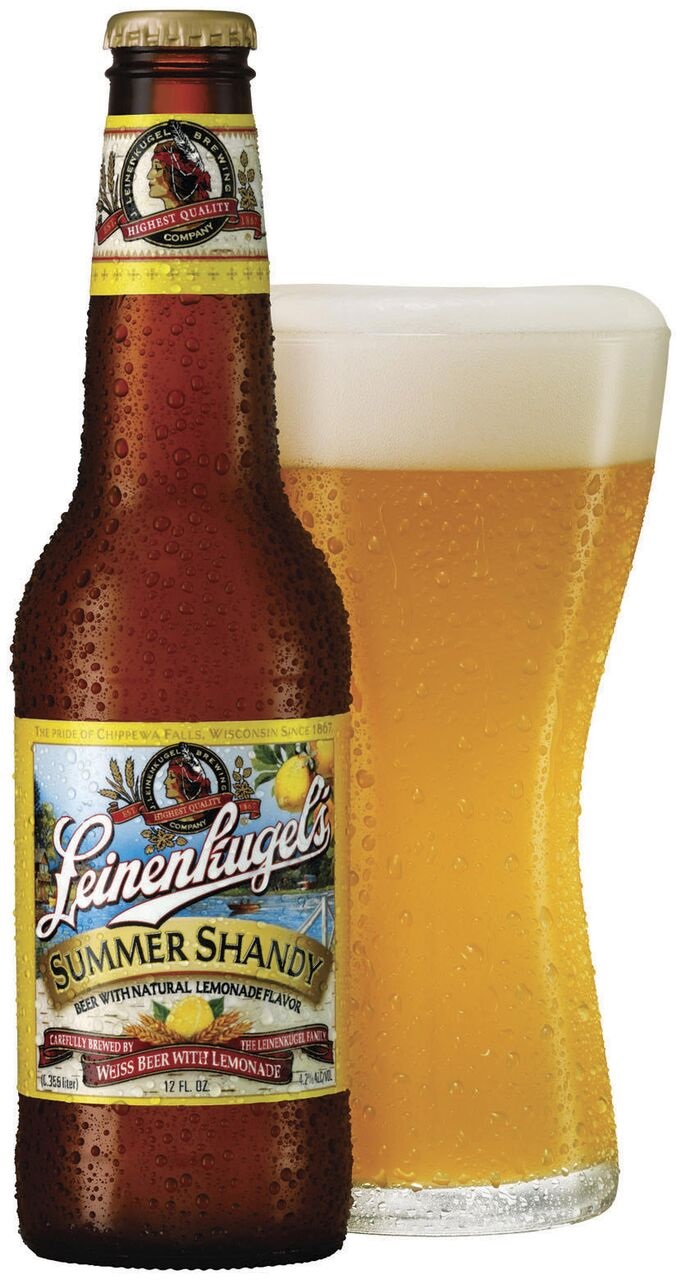The Power of the Flagship: Top-selling Brands Drive Growth for Breweries

(Illustration by Michael Byers)
On store shelves across the country, a breadth of choices is the norm. Breweries are making more brands of beers than ever before within the most diverse array of styles the world has seen. The ever-changing guard has proved to be a successful path for many breweries, but there are still plenty relying on the power of the flagship beer to point them in the right direction.
Whether it comes about through serendipity or a calculated maneuver, one thing is clear: There’s power in a flagship brand, even in today’s crowded marketplace.
“We’ve been at this for 20 years and always been a brewery that makes a lot of highly eclectic, specialized beers,” says Mike Stevens, president and CEO of Founders Brewing Co. “You can be successful doing that, but you’re always chasing the next thing. When you have a brand that really takes off and ignites the consumer, it helps you to really start planning long-term and solidifies you as a national player.”
For Founders, that lead brand has been All Day IPA, which quickly became the company’s top-selling beer a year after it joined the core lineup in 2013. In 2014, it sold the same volume as the brewery’s long-standing brand, Centennial IPA. The writing was on the wall. Founders never looked back.
Today, All Day IPA makes up just under 60 percent of volume, but its impact is felt beyond continued sales.
Demand for All Day IPA provided Founders with new points of distribution, which meant other brands saw increased sales as they were stocked next to the popular beer. In 2016, Founders Porter (11.1 percent), Dirty Bastard Scotch Ale (14.2 percent) and Rubaeus (57.2 percent) were all up in sales compared with 2015. On its own, All Day IPA has become the top-selling canned craft beer, as tracked by market research company IRI, and is a top-five IPA, too. “We wouldn’t have decided on a $40 million expansion without the momentum of All Day,” Stevens says. “Behind that brand, it can help us be a million-barrel brewery.”
In April, Founders also announced plans to open a second location in Midtown Detroit, a move aided by the continued success of its lead brand.

(Photo courtesy Firestone Walker Brewing Co.)
Like Founders, Firestone Walker Brewing Co. has also received a big boost from a surprise powerhouse. 805 Blonde Ale, only available in four states, has become the highest-volume brand for the 21-year-old brewery. In 2015, while only available in California, 805 cracked the top-30 national craft brands tracked by market research company IRI. It now represents more than half the brewery’s production, and dollar sales were up more than 40 percent in IRI-tracked stores for the first quarter of 2017.
Co-founder David Walker attributes the success to 805’s ability to reach customers who hadn’t been focused on “craft beer” as a concept before. “This group is the overwhelming majority of beer drinkers, so entering that world was an education,” he says.
Ultimately, the hope is that 805 converts consumers to other brands. “805 is only our lead brand in volume, not in mind share,” Walker says, pointing out Luponic Distortion and the new Leo v. Ursus lines, both rotating IPAs that change recipes each quarter. 805 is a hopeful entry point, not necessarily the end-all brand despite its quantitative hold on sales and volume. There are many other Firestone Walker beers to explore.
Hops aren’t the only thing that can help a brewery plant its flag.
At Anderson Valley Brewing Co. in Boonville, California, there’s no denying the brewery’s lineup of goses has helped propel the business in what president and CEO Trey White calls “the age of the IPA.” In 2016, three seasonal gose brands—two fruit-flavored beers and a more “classic” interpretation of the German style—made up a third of Anderson Valley’s volume. But it wasn’t supposed to get that far.
In late 2013, White and his team were readying their Highway 128 series, a collection of low-ABV beers named after the California road not far from the brewery. After visiting the Southeast and sampling Westbrook Brewing Co.’s Gose, White was intrigued at the possibility of making their own. The series was set to release a pale ale, gose and pilsner. The pale ale “did fine,” White says, and then The Kimmie, The Yink & The Holy Gose was released.
“We decided pretty quickly to throw out the window the idea of doing pilsner,” says White. Holy Gose was selling 10 times as much in volume as Keebarlin’ Pale Ale. So far, Holy Gose has given rise to three variants, Briney Melon Gose, Blood Orange and G&T Gose, a play on the gin and tonic cocktail that uses gin and tonic spices to hold up to the barrel wood notes more effectively. Combined, the four brands are the best-selling Anderson Valley beers in the country outside the brewery’s home market in California, where Boont Amber reigns supreme. For Anderson Valley, the expansion emphasizes a lucky find. As other breweries may struggle with seasonal releases—White points out pumpkin beer in particular—these goses have sold well no matter the time of year.

(Photo courtesy Anderson Valley Brewing Co.)
“Rightly or wrongly, the seasonal category has gotten pretty darn messy, but the goses have overtaken that issue for us,” White says. “East of the Rockies, it wasn’t Boont Amber that was growing our brand. Gose has been it.”
Another German style helped Jacob Leinenkugel Brewing Co. claim an entire subsection of the American market.

(Photo courtesy Jacob Leinenkugel Brewing Co.)
“Shandy was never meant to be a lead brand for us,” says Dick Leinenkugel, president and chief beer merchant for the company that bears his family name. “We wanted to know more about what the Germans drink in the summer to create a beer that harkens back to our family’s roots. We talked about a kölsch and hefeweizen, then we discovered this mix.”
What came about was Leinenkugel’s Summer Shandy, a combination of the brewery’s weiss beer with lemonade flavoring.
The beer was released in Wisconsin in summer 2007, the same time as Miller Chill and its multimillion-dollar ad campaign rolled out. The coincidence had Leinenkugel worried due to the similar flavor profile of each brand.
Despite making 30,000 barrels for an April release to 11 states, the amount of beer only made it until early July. It was supposed to last through Labor Day.
In 2008, production was doubled and sent to the same number of states, but again, it was gone in July. There was 100,000 barrels in 2009. Then an expansion into four seasonal shandies, adding grapefruit, pumpkin and cranberry-ginger.
Leinenkugel says his brewery now owns roughly 90 percent of the shandy category in the U.S. and in 2016 estimated production of 650,000 barrels across all the brewery’s shandies.
“After 2008, I was surprised nobody came right after that category,” Leinenkugel says. “It’s rare in a beer person’s career where you get to lead a segment like that.”
And therein lies the common denominator among examples from Founders, Anderson Valley and Leinenkugel’s. Now that they have successful brands synonymous with their breweries and a style category, the popularity of their flagships relies on continued focus and expansion. There’s always time to create something new, but it’s impossible to ignore what fills up a balance sheet.
“There are a lot of 21- to 25-year-olds who think about Anderson Valley as a gose brewery now,” White says. “That can be good and bad.”
Stevens echoed a similar situation for Founders.
“It allows us to breathe a little easier when you have a product that clearly has a strong future,” says Stevens. “Not that we’re giving up on diversity we have with our brands, but this gives us insurance, which any business owner would want.”
Bryan Roth
Bryan Roth is a North Carolina-based writer. Find him tweeting @bryanroth.

Leave a Reply